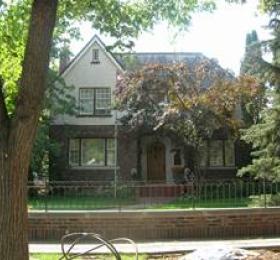Andrew Boyd Residence
- Designated
Description of the Historic Place
The Andrew Boyd Residence (also known as the Lorne McConnell House) features a two storey house constructed in 1929 in the neighbourhood of City Park. The home is located on a large double lot at the corner of 9th Avenue North and Princess Street.
This historic place, located at 803 9th Avenue North, was designated as a Municipal Heritage Property in 2015. The designation is limited to the building’s exterior, and does not include the rear addition completed in 2012.
Heritage Value
The heritage value of the Andrew Boyd Residence lies in its Tudor architectural design, a style known for its steeply pitched roofs and tall narrow windows. The home is an excellent example of a traditional 1920’s Tudor-style home, which is a relatively unique style of architecture in Saskatoon. Architectural elements featured on this home’s exterior, and those of which are characteristic of the Tudor-style, include a steeply pitched roof with a projecting front-gabled extension, brick exterior with stucco cladding on the upper level, an arched front doorway with decorative stone trim, and a large brick chimney with decorative chimney pots. The Andrew Boyd House has retained many of the features of the original 1929 home. An addition to the rear of the property was completed in 2012; however, all materials used were chosen to complement the existing exterior finishes.
The heritage value of the Andrew Boyd Residence also lies in its association with two prominent citizens in Saskatoon: Andrew N. Boyd and Dr. Lorne McConnell. Boyd, who founded the auto dealership Boyd Bros. (located at the corner of 24th Street and 2nd Avenue), came to Saskatoon from Radisson and North Battleford in 1922. He was a prominent figure in the Knox United Church and past president of the Saskatoon Club from 1930 to 1931.
The Andrew Boyd Residence was later purchased by Dr. Lorne McConnell who began his medical practice in Saskatoon in 1912. Dr. McConnell had served with the British Army Medical Corps during World War I, and in the early 1930’s studied at McGill University’s Neurological Institute before continuing his studies at the Mayo Clinic in Rochester, Minnesota. Dr. McConnell was a pioneer in the field of neurosurgery in Western Canada and before his retirement in 1967 served as Chief of Surgery at Saskatoon City Hospital for a number of years.
Source: City of Saskatoon Bylaw No.8056 / City of Saskatoon Built Heritage Database / Canadian Register of Historic Places
Character Defining Elements
Key elements which contribute to the heritage value of this historic resource include:
- Its Tudor style of architecture, evident in: the materials, shape and slope of its steeply pitched roof, its front gabled extension, its brick exterior with stucco cladding on the upper level, arched front doorway with decorative stone trim, the large brick chimney with decorative chimney pots, the concrete/stone trim and accents, its cedar shingles and the tall narrow wood-framed windows; and
- Those elements that reflect its associations with Andrew Boyd and Dr. Lorne McConnell, including its location on its original site.

